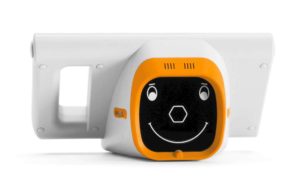A reprint from Healio Magazine

In this guest editorial, David Brottman, MD, FAAP, a recently retired pediatrician in Arlington, Illinois, discusses device-based vision screening strategies for children, and how new technology can improve outcomes in the primary care setting.
In 2015, the AAP, the American Academy of Ophthalmology and the American Academy of Optometry updated their vision screening policy statements to include a recommendation to use photoscreening for children aged 1 to 3 years.
I welcomed this development because it gave our practice an opportunity to re-evaluate how we had been performing vision screenings. I had long been skeptical of just how accurate our vison tests were using traditional methods. Vision screening can often be time consuming and occasionally even frustrating to perform in preschoolers. Vision screening that requires a child to respond to an eye chart, for example, has been shown to have poor predictive value, especially in the first 3 to 4 years of life.
 Ckick here for more info on photo vision screening
Ckick here for more info on photo vision screening
Photoscreening is also invaluable when evaluating children with intellectual and cognitive problems who cannot read an eye chart. The AAP statement noted: “Screening for amblyogenic refractive error with instrument-based screening is not dependent on behavioral responses of children, as when visual acuity is measured. Instrument-based screening is quick, requires minimal cooperation of the child, and is especially useful in the preverbal, preliterate, or developmentally delayed child. Children younger than 4 years can benefit from instrument-based screening, and visual acuity testing can be used reliably in older children.”
Evaluating devices
With the new recommendations in place, our group evaluated the photoscreening devices on the market. We prioritized high specificity and sensitivity among our selection criteria; and the tools we considered varied in cost and sophistication, from cell phone apps to more expensive screening machines. As part of our process, we compiled data on the options and then presented this information to our referral network of optometrists and pediatric ophthalmologists. We challenged them to consider what they would want used on their own children. Certainly, they understood the ramifications regarding over- and under-referrals. After a careful review of the information, each provider chose the PlusoptiX vision screener. In a recent study, the device outperformed two others as an autorefractor, particularly with respect to astigmatism power and axis. The sensitivity of device was 91%, and the specificity was 71%.
When we actually demoed the products, we found that the PlusoptiX vision screener was a perfect fit for our practice. The screening fit easily into our workflow because the staff can conduct the test while the physician is out of the exam room. It is efficient because it takes less than a minute to perform. When our physicians return to the exam room, the results are already incorporated into our electronic health record.
We have found it to be a fantastic addition to our practice. We are uncovering more vision problems sooner, and the feedback from our ophthalmology colleagues has been extremely positive. We can diagnose myopia much earlier, enabling us to refer patients for treatments like orthokeratology years earlier than we could previously.
 Ckick here for more info on photo vision screening
Ckick here for more info on photo vision screening
Electronic vision screening tests = earlier detection, earlier treatment
Earlier detection results in better outcome at lower cost. For this reason, all science-based professional organizations recommend early and frequent vision screenings beginning as early in life as possible. Regular vision screening assessments in early childhood have been shown to reduce the risk for persistent amblyopia at 7 years of age by more than half. The AAP notes the availability and extensive validation of device-based screening in field studies and in the office. The organization also states that screening instruments detect amblyopia, high refractive error and strabismus — the most common conditions that produce visual impairment in children.
Although they can be used at any age, screening devices have better success when the child is older than 18 months of age, according to the AAP. Instrument-based screening can be repeated annually, through age 5 years, or until “visual acuity can be assessed reliably with optotypes.” The AAP concludes: “Using these techniques in children younger than 6 years can enhance detection of conditions that may lead to amblyopia and/or strabismus compared with traditional methods of assessment.”
On the heels of the AAP direction, the U.S. Preventive Services Task Force released a statement supporting device-based screening technologies for preschool vision screenings with a level B evidence rating. The Affordable Care Act requires that health plans fully cover preventive services that have an A or B rating (CPT code 99177 for an immediate result in office, CPT 99174 for remote interpretation).
Conclusion
Photoscreeners like the PlusoptiX estimate refractive error, media clarity, ocular alignment and eyelid positions. Abnormalities in these characteristics are risk factors for the presence or development of amblyopia, which, when left untreated, is the most frequent cause of preventable vision loss in children (see sidebar). Using the device with its well-validated criteria and settings, we can more easily obtain high-quality referrals. Photoscreening takes less than a minute, and it requires less attention and cooperation from the child compared with traditional visual acuity screening. Because not all school-age children will need a complete eye examination, photoscreening is a cost-effective method for identifying those who do.
Our ophthalmology colleagues have been amazed at what we have uncovered with PlusoptiX. It is truly eye opening how much better this technology enables us to improve our care for children.
 Ckick here for more info on photo vision screening
Ckick here for more info on photo vision screening

